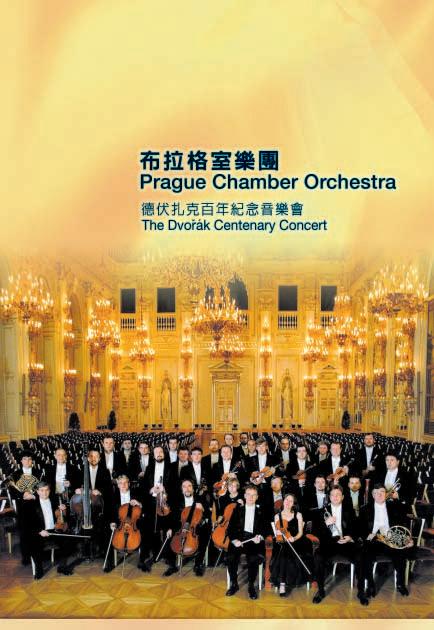
1.3.2004
香港文化中心音樂廳
Hong Kong Cultural Centre Concert Hall


1.3.2004
香港文化中心音樂廳
Hong Kong Cultural Centre Concert Hall
德伏扎克百年紀念音樂會
樂團首席 安東尼.哈拉爾
Antonín Hradil Concert
Master
演出長約1小時35分鐘,包括一節20分鐘中場休息 Running time: approximately 1 hour 35 minutes, including a 20 minute interval
節目詳情 For programme details Page 27 頁
為了讓大家對這次演出留下美好印象,請切記在節目開始前關掉手錶、無㵟電話及傳呼機的響鬧裝 置。會場內請勿擅自攝影、錄音或錄影,亦不可飲食和吸煙,多謝合作。
To make this performance a pleasant experience for the artists and other members of the audience, PLEASE switch off your alarm watches, MOBILE PHONES and PAGERS. Eating and drinking, unauthorised photography and audio or video recording are forbidden in the auditorium. Thank you for your co-operation.
沒有指揮的布拉格室樂團很講求團員之間的默契。
這類樂團不但在捷克寥寥可數,即使在全世界也不多見。
團員不用聽命於指揮,但顧及整個樂團的合作,緊守室樂團成員 的崗位。
布拉格室樂團的風格源於十八世紀末古典 時期的規格,配器包括多組弦樂四重奏(十 一把小提琴、四把中提琴、四把大提琴和 兩把低音大提琴)、雙管樂六重奏(長笛、 雙簧管、單簧管、巴松管、法國號和小號) 以及定音鼓。
布拉格室樂團其實是由捷克斯洛伐克電台 交響樂團的獨奏者自發成立的。最初,該 團多個樂器組的首席樂師自組一個小型合 奏團,以配合當時交響樂團所選的新曲 目,大部份皆是波希米亞古樂。此傾向反 映在樂團錄製的首張唱片,卡爾.斯塔米 茨作品《管弦樂四重奏》內,這張唱片於 1951 年 10 月灌錄。翌年,布拉格室樂團在 譽滿樂壇的布拉格春季音樂節演出,旋即 成為捷克最炙手可熱的合奏團,再加上布 拉格室樂團漸漸摒棄過往以完整配器演奏 古樂的規格,就更令它聲譽日隆。
由於布拉格室樂團越來越受歡迎,令團員分 身不暇,不能兼顧電台樂團的工作,結果 1965年布拉格室樂團正式脫離電台樂團。共 產政權垮台後,室樂團的樂師自組布拉格室 樂團代理有限公司,負責樂團日常運作。
半世紀以來,布拉格室樂團以精湛演奏飲譽 捷克及國際樂壇。樂團每年都在捷克春季、 秋季兩個大型音樂節演出,平均每年演出八 十場音樂會,當中八成在捷克境外。
布拉格室樂團是歐洲多個音樂節的常客, 包括比亞麗茲、萊茵高音樂節及維爾茨堡 的莫扎特音樂節,另外也曾作客拉丁美 洲、美國、加拿大、日本、南韓、馬來西 亞及新加坡。
布拉格室樂團灌錄的多張唱片獲獎無數, 包括著名的 Suprahon 唱片公司金碟獎、維 也納笛鐘唱片獎及查理.柯羅斯音樂學院 唱片大獎。
雖然名為無指揮的室樂團,但布拉格室樂 團卻不抗拒跟指揮家合作,特別在灌錄唱 片時,例如樂團跟瓦克拉夫.紐曼及基 德.艾爾柏拉舒特等指揮就合作得天衣無 縫;此外,樂團還跟著名指揮查理斯.莫 克拉斯擬定了長期計劃,合作灌錄莫扎特 交響曲全集。
對不少獨奏者來說,跟布拉格室樂團合作 是種挑戰 除了演奏獨奏部份,還要領 導樂團。可是,要是獨奏者不習慣領導樂 團,這個重任就落在樂團首席身上了。因 此,布拉挌室樂團的樂手會小心挑選首 席,因為他要帶領整個樂團,為演奏提供 明確的表達。現任樂團首席為安德烈耶. 庫卡爾及安東尼.哈拉爾,次席為米蘭. 拉爾杰克。
The Prague Chamber Orchestra boasts a unique position not only among Czech ensembles but worldwide, as similar formations are quite rare and performing music without a conductor requires a special rapport between the orchestra members.
Each member of the orchestra relates not to the conductor’s baton but to the ensemble as a whole, assuming the role of a chamber music player even though the instrumentation is much larger.
This style of orchestra stems from the late 18th century. The instrumentation thus comprises of a multiplied string quartet (11 violins, 4 violas, 4 cellos and 2 basses) supplemented with a double wind sextet (flutes, oboes, clarinets, bassoons, French horns, trumpets) and timpani.
The formation of the Prague Chamber Orchestra arose as an initiative of the solo players in the Czechoslovak Radio Symphony Orchestra. These soloists got together to start a smaller ensemble better suited for the new programming, then focused largely on the older Bohemian music. This was reflected by the ensemble’s first recording, Orchestral Quartet by Karel Stamic, made in October 1951. Their subsequent appearance at the prestigious Prague Spring Festival a year later, propelled the Orchestra into the ranks of

© Photo Pajer
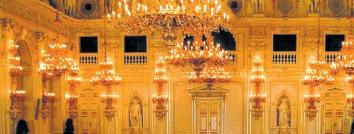
the most demanded Czech ensembles, a status further enhanced by the growing tendency to abolish the former practice of full instrumentation for much of the older music.
In time the growing demand for the Prague Chamber Orchestra started to clash with the duties of the players as members of the radio orchestra and in 1965 the situation logically led to the Prague Chamber Orchestra becoming an independent entity. Following the fall of the Communist regime the musicians took over the operation themselves through their own company, PKO Agency Ltd.
The impressive half century of performances by the Prague Chamber Orchestra has left a distinguished mark on both the domestic and international concert scene. The Orchestra has long been a regular participant at the two major Czech music festivals – the Prague Spring and Prague Autumn Festivals. In addition, the Orchestra plays on average some 80 concerts annually of which four-fifths of all concerts take place abroad.
Apart from frequently appearing around Europe at festivals such as Biarritz, the Rheingau Festival or the Mozartfest in Würzburg, the Orchestra also travels overseas and has been to Latin America, to
the US, Canada, Japan, Republic of Korea, Malaysia and Singapore.
The Orchestra has recorded a great many scores and its extensive discography boasts a number of prestigious prizes such as Suprahon’s Golden Disc, the Wiener Flötenuhr and the Grand Prix du Disque Académie Charles Cros.
Despite its name and the prevailing mode of performing music, the Prague Chamber Orchestra does not shun working with a conductor. In the recording studio, the Orchestra has achieved very successful collaborations with Václav Neumann, Gerd Albrecht and the long-term project to record all of Mozart’s symphonies conducted by Sir Charles Mackerras.
For many soloists, playing with the Prague Chamber Orchestra creates a challenge to try and lead the Orchestra as well as playing their own instrument. However, when a soloist is not given to this mode of playing, the key role of the Orchestra’s coordinator passes to the concert master. As a consequence the role of the concert master is selected very carefully as he gives the whole ensemble’s performance a definite expression. At present, the Orchestra’s concert masters are Ondˇrej Kukal and Antonín Hradil and the assistant concert master is Milan Lajcˇík.
安東尼.哈拉爾
樂團首席
哈拉爾 1957 年生於捷克布倫塔爾,肄
業於布爾諾的揚納切克音樂及戲劇藝 術學院及國立音樂學校,並在布爾諾 愛樂樂團任小提琴手多年。
遷居奧廖穆茨後,哈拉爾一直於摩拉 瓦劇院樂團任首席小提琴, 1990 年成 為摩拉瓦愛樂樂團首席小提琴;除了 固定的獨奏演出,他還兼任奧廖穆茨 室樂團藝術總監。
哈拉爾與布拉格室樂團定期合作兩年 後,2003年2月獲選為樂團藝術領袖, 擔任樂團首席一職。
Born in 1957 in Bruntal, Czech Republic, Antonín Hradil studied at the State Conservatory of Music and the Janacek Academy of Music and Drama Arts (JAMU) in Brno. He was a violinist in the Brno Philharmonic Orchestra for several years.
After his move to Olomouc, he was the principal violinist in the Morava Theatre Orchestra, and in 1990 he became the principal violinist of the Moravian Philharmonic Orchestra. Hradil is also the artistic director of the Olomouc Chamber Orchestra.
After two years regular collaboration with the Prague Chamber Orchestra, Hradil was elected as the artistic leader and concert master of this ensemble in February 2003.
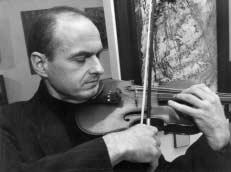
德伏扎克
文:拜恩.湯臣
十九世紀九十年代初,德伏扎克 (1841 1904) 旅居美國時,曾對《紐約先驅報》的記 者說,美國黑人的靈歌「可以成為新的民族 音樂學派的堅穩基礎,美國可以有自己的音 樂,一種由自己國土成長、優秀的、有自己 風格的音樂,來自自由、偉大的國度的一把 自然聲音。」民族音樂發展一直是德伏扎克 最關心的題目,當時他聲譽正隆,既是歐洲 音樂的泰斗,也是民族音樂運動的前線 代表。
正是這兩個角色造就了他應邀到紐約的國家 音樂學院當了三年院長。縱使他卑微的出身 跟他斐然的成就不相稱,卻使他能繼承斯梅 塔納成為捷克音樂文化的倡導者。德伏扎克 的故鄉是前斯拉夫波希米亞王國, 1526 年 起被奧地利帝國統治。十九世紀六、七十年 代,由於統治者放鬆了對捷克語言及文化的 控制,給予像斯梅塔納和德伏扎克等民族音 樂家發展的機會,而統治者與波希米亞民族 主義者之間的緊張關係,一直影響着德伏扎 克的風格和音樂。
德伏扎克的早期事業是用掙扎和鬥志建立 的,他的家人在布拉格外圍經營肉店及小 客棧,假若沒有成為音樂家,德伏扎克便 該繼承這門家族生意。在鄉村學校他得到 了音樂的啟蒙,不久就在教堂和鄉村的樂 隊拉奏小提琴。十二歲時他被送到一個叫 茲朗尼斯的小鎮學了三年德文,同時師隨 當地合唱團長李曼。其後,他在北波希米 亞的一所德國學校就讀一年,學了管風 琴,得以入讀布拉格管風琴學院。 1859 年
畢業後,就在科姆札克的舞團演奏中提 琴。隨着布拉格首個捷克劇院在 1862 年開 幕,科姆札克的樂隊成為劇院樂團的主要 成員,起初他們演奏的曲目包括德國、法 國和意大利作曲家的音樂,但在 1866 年斯 梅塔納成為指揮後,就以奏捷克及斯拉夫 音樂家的作品為主。德伏扎克在樂團工作 至 1871 年,其後專注作曲工作。
接着數年,德伏扎克的成績只可以說是中 規中矩,由布拉姆斯 (1833 1897) 參與評 審的奧地利國家獎學金補助了他的生活。
1877 年布拉姆斯向音樂出版商森樂克推薦 德伏扎克的作品,森樂克同意出版他的一 輯二重奏,並委約他創作《斯拉夫舞曲》,
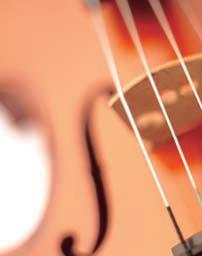
當翌年這些作品面世後,德伏扎克的事業 開始起飛,這些作品很快就在紐約和歐洲 各地演出,更多的委約和客串指揮的邀請 紛紛而來。其後撰寫的《斯拉夫狂想曲》、 《弦樂六重奏》和《第六交響曲》,令他的事 業更上一層樓。
十九世紀八十年代初,日漸高漲的民族主 義衝突出其不意地影響了德伏扎克的事 業,他的歌劇《迪米特伊》1882 年在新捷克 歌劇院首演,但反捷克的情緒使此劇不能 在德國和奧地利演出,連他的管弦音樂也
被減少演奏 。他唯有減弱作品中的民間音 樂元素,並轉往英國發展;出版社曾一度 減少他的酬金,但後來緊張的氣氛緩和,
森樂克再委約他寫第二輯《斯拉夫舞曲,作 品 72》(1886) ,德伏扎克因而開始了他的第 二個斯拉夫時期。
往後的日子,德伏扎克漸漸跳出民族與政 治的爭拗,創作不同類型的音樂,涉及差 不多每種音樂體裁。他的作品在英、美和 歐洲都大受歡迎,歷久不衰,顯見其音樂 的魅力、強烈的表現力及對民族傳統的不 離不棄。他的音樂現在仍是波希米亞文化 和現代捷克的象徵,亦使人想起很多國家 追求民族身份和獨立所面對的鬥爭,以及 浪漫主義的精神力量。
中譯:黃家慧
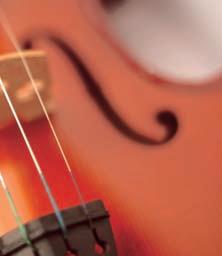
民族音樂發展一直是德 伏扎克最關心的題目, 旅居美國時,他聲譽正 隆,既是歐洲音樂的泰 斗,也是民族音樂運動 的前線代表。
by Brian C Thompson
While in the US in the early 1890s, Antonín Dvoˇrák told a reporter from the New York Herald that in African-American spirituals he had “found a secure basis for a new national musical school. America can have her own music, a fine music growing up from her own soil and having its own character – the natural voice of a free and great nation”. It was a subject close to his heart. He was by this time at the height of his fame: a towering figure in European music and the foremost representative of musical nationalism.
It was the combination of these two roles that led to Dvoˇrák’s three-year tenure as head of New York’s National Conservatory. If his humble background made his rise to greatness unlikely, it also helped to prepare him to follow Bedrich Smetana as the leading voice of Czech musical culture. Dvoˇrák’s homeland, the former Slavonic kingdom of Bohemia, had been under Austrian rule since 1526. In the 1860s and 1870s, the relaxation of state controls over the use of the Czech language and expressions of national culture provided an opportunity for composers such as Smetana and Dvoˇrák. The tensions that remained would continue to influence Dvoˇrák’s identity and music.
Dvoˇrák’s early career was one of struggle and determination. His family ran a butcher shop and inn, outside Prague, which he would likely have inherited had he not become a musician. He received his first music lessons in the village school and before long was playing the violin in the church and the village band.
At the age of 12 he was sent to the small town of Zlonice for three years to learn German and while there he furthered his musical education with the cantor Antonín Liehmann. After this, he attended a German municipal school in northern Bohemia for a year, where he took organ lessons, and then enrolled in the Prague Organ School.
On his graduation, in 1859, he earned a living by playing viola in the dance band of Karel Komzak. With the opening of Prague’s first Czech theatre, in 1862, Komzak’s group became the basis of the theatre orchestra. The repertoire at first consisted of works by German, French, and Italian composers, but in 1866 Smetana became the conductor and began programming works by Czech and Slavic composers. Dvoˇrák remained a member of
the orchestra until 1871, when he left to pursue a career in composition.
Dvoˇrák enjoyed only modest success in the early 1870s, supplementing his income with funding from the Austrian State Stipendium, of which Johannes Brahms (1833–1897) was an adjudicator. In 1877, Brahms wrote to the publisher Fritz Simrock urging him to consider some of Dvoˇrák’s works. Simrock agreed, publishing a set of duets and commissioning the Slavonic Dances. When they appeared, in 1878, Dvoˇrák’s career took off. They were soon performed in New York and throughout Europe, leading to further commissions and offers to guest-conduct. Dvoˇrák scored further successes with the Slavonic Rhapsodies, the String Sextet and the Sixth Symphony.
However rising national tensions unexpectedly began to play into Dvoˇrák’s career in the early 1880s. His opera Dimitrij was given its premiere at the New Czech Theatre in 1882, but the anti-Czech mood prevented its production in Germany or Austria, and reduced performances of Dvoˇrák’s orchestral works . He responded by tempering the folkloric elements in his works, and by

Dvoˇrák’s music is now very much a living symbol of Bohemian culture and of the modernday Czech Republic. It also reminds us of the struggle for national identity and independence faced by many nations and the strength of the romantic spirit.

spending more time in England. For a time, his publisher reduced his fees, but eventually tensions eased and Simrock commissioned a second set of Slavonic Dances , Op 72 (1886), and Dvoˇrák embarked upon a second Slavonic period.
In the years that followed Dvoˇrák was increasingly able to look beyond the ethnic and political disputes of his region. He composed in nearly every genre of his time, and his music was in great demand in
Britain, the US and throughout Europe. Its enduring popularity is a reflection of its charm, expressive power and its strong ties to folk traditions.
Dvoˇrák’s music is now very much a living symbol of Bohemian culture and of the modern-day Czech Republic. It also reminds us of the struggle for national identity and independence faced by many nations and the strength of the romantic spirit.
E 大調弦樂小夜曲,作品 22
中板
圓舞曲節奏
諧謔曲(活板)
小廣板
終曲(活潑的快板)
E 小調小提琴及管弦樂
馬祖卡舞曲,作品 49
小提琴 安東尼.哈拉爾
Serenade for Strings in E major, Op 22 Moderato
Tempo di Valse Scherzo. Vivace Larghetto Finale. Allegro vivace
Mazurek in E minor, Op 49 for Violin and Orchestra
Antonín Hradil Violin
-中場休息20分鐘 20 minute interval –
F 小調小提琴及管弦樂浪漫曲,作品 11
小提琴 安東尼.哈拉爾
D 大調《捷克組曲》,作品 39
前奏曲
波爾卡舞曲
索塞斯卡舞曲(小步舞曲)
浪漫曲
終曲(富里安舞曲)
Romance in F minor, Op 11 for Violin and Orchestra
Antonín Hradil Violin
Czech Suite in D major, Op 39
Prelude
Polka
Sousedská (Minuetto)
Romance
Finale (Furiant)
拍掌
較長篇的樂曲分為不同長度的樂章部份。
請待整首樂曲奏完後才報以掌聲。
Applause
Longer pieces of music are often divided into sections or movements. Applause is customary at the end of a complete piece of music not between movements.
大調弦樂小夜曲,作品 22
德伏扎克的小夜曲和組曲性質獨特, 既展現了作曲家精湛的配器造詣,又 不失室樂作品的特質。德伏扎克的作 品目錄中共有兩首小夜曲及兩套 組曲。
E 大調弦樂小夜曲寫於 1875 年,當時 作曲家生活愜意,其愉快心情躍然紙 上:歌劇《國王與煤礦工》終於為人受 落,而且維也納一個委員會認同其成 就,頒了一筆國家撥款給他,令德伏 扎克的事業攀上首個高峰。第一樂章 的主題婉約如歌,一開始就能將聽眾 迷住。作曲家巧妙地把這個主題安排 在終樂章結尾重現,使樂曲首尾 呼應。
第二樂章是〈圓舞曲〉,中段特別優 美,是作曲家抒情風格的傑出範例。
可是,最能展現這種抒情風格的卻是 第四樂章〈小廣板〉:綿長的主題接連 在不同樂器組出現,旋律越趨精巧, 整個樂章效果猶如將夜曲以歌聲唱 出。第三樂章清新可喜,〈終曲〉朝氣 蓬勃,表現出德伏扎克特有的生 命力。
Serenades and suites occupy a special place in Dvoˇrák’s oeuvre. We sense in them on the one hand his orchestral mastery, but at the same time they are closely related to his rich output in chamber music. In Dvoˇrák’s catalogue we find two Serenades and two Suites.
The Serenade in E major for string instruments was written in 1875. Its mood seems to reflect the happy life which its composer was experiencing at the time. He had gained his first great successes – the opera Král a uhliˇ r (King and Collier) was at last well-received – and a committee in Vienna had recognized Dvoˇrák’s achievements by awarding him a state grant. The theme of the first movement of the Serenade (very skilfully framing the whole composition through its return before the end of the final movement) captivates us at the very beginning with its songlike character and sentiment. The waltz of the second movement is remarkable especially for its trio, one of the most outstanding examples of Dvoˇrák’s lyricism.
This lyricism, however, comes to the fore mainly in the fourth movement, Larghetto. Its long-breathed theme is elaborated successively by individual instrumental groups and the whole movement has the effect of a nocturne in song. In the charming third movement and the energetic Finale we find Dvoˇrák’s typical vitality.
E
小調小提琴及管弦樂
馬祖卡舞曲,作品 49
德伏扎克年輕時曾在卡拉爾.科姆扎 克聞名遐邇的樂隊及布拉格臨時劇院 當中提琴手,合作的指揮包括著名捷 克作曲家斯梅塔納。
由於德伏扎克深諳小提琴及中提琴的 演奏技巧和可塑性,其小提琴作品在 各方面尤其出眾。此曲由森洛克委約 創作,在表現法和色彩上接近《斯拉夫 舞曲》,但格調較《斯拉夫舞曲》簡樸率 真,這種分別在處理複音織體時特別 明顯。
本曲旋律優美,音色豐富,由兩個主 題發展而成:第一主題活力充沛,熱 情奔放;第二主題則溫柔婉約,節奏 輕柔,跟第一主題相映成趣。
As a young musician Antonín Dvoˇrák used to play the viola with Karel Komzak’s famous band, and also in the Provisional Theatre in Prague where conductors included another well-known Czech composer, Bedrich Smetana.
Dvoˇrák’s intimate knowledge of viola and violin techniques and the potential of both related instruments, makes his violin compositions more rewarding in all respects. His Mazurek, commissioned by the publisher Simrock, draws its expression and colour from sources of Central European folk music just like his Slavonic Dances and in contrast to the latter it is plainer and more simple, especially in the polyphonic texture.
This beautifully melodious work, with its full sound, is based on two themes. The first one is vigorous and wild while the second, as its tender and charming counterpart, excels with the gentle rhythm of its melody line.
-中場休息20分鐘
20 minute interval –
F 小調小提琴及管弦樂
浪漫曲,作品 11
德伏扎克跟安娜.塞麥克 (1875) 婚後 不久,寫了兩首弦樂四重奏(第五首 F 小調、第六首 A 小調),表達幸福、憧 憬未來的喜悅之情(畢竟之前經歷了多 年艱苦)。
由於他並不打算出版這兩首新作(以及 之前的三首四重奏),就以 F 小調四重 奏的第二樂章為藍本,寫了一首給小 提琴及小型樂團演奏的作品,題為「浪 漫曲」。
這首浪漫曲像首平和親切的歌曲,帶 着幾分憂鬱與深沉;無論表現手法或 聲音,都溫柔優雅,不落俗套,是首 十分討人歡喜的作品。
In the period after his marriage to Anna Cermak (1875) Dvoˇrák composed two string quartets (No 5 in F minor and No 6 in A minor) expressing his delight (which finally came after difficult years) and prospects for a happy future.
Since Dvoˇrák did not plan to publish the new quartets (nor his three previous quartets) he used the slow movement from the quartet in F minor to create the composition Romance for violin and small orchestra.
It is a tranquil and very intimate song with a touch of melancholic contemplativeness. A very pleasant composition with etherial tenderness both in expression and sound.
39
繼弦樂、管樂兩首小夜曲獲得成功之 後,德伏扎克寫首小夜曲給小型交響 樂團也就順理成章了。單聽 D 大調《捷 克組曲》第一樂章〈前奏曲〉,就能感到 德伏扎克是朝着這個目標邁進;第四 樂章〈浪漫曲〉以英國管和哀怨的長笛 獨奏,就與之前兩首小夜曲的抒情樂 段有異曲同工之妙。由於餘下的樂章 (第二、第三、第五)是傳統風格的捷 克舞曲,因此作曲家就將樂曲名為「組 曲」(浪漫時期前的「組曲」是一套主要 由多首舞曲風格樂曲組成的作品)。
組曲况的舞曲多姿多采 〈波爾卡 舞曲〉(第二樂章)抒情色彩比舞蹈感更 為強烈;〈索塞斯卡舞曲〉(第三樂章, 類似小步舞曲)含蓄而歡快,但在最後 的變奏出現了一個出人意表的樂段, 在旋律和情感上營造與別不同的 效果。
終曲〈富里安舞曲〉經常被用來與前一 年寫的《斯拉夫舞曲》比較,但〈富里安 舞曲〉其實勝過多首《斯拉夫舞曲》。這 首匠心獨運的〈富里安舞曲〉,不但將 這種經常轉換拍子的古老捷克民間舞 曲格式化,而且作曲技巧精湛,在對 位及和聲的運用上展現出無限創意, 堪稱典範。而作曲家巧奪天工的配器 更為此曲錦上添花,連定音鼓也擔當 重要角色:曲終的定音鼓獨奏不但完 美地總結全套捷克組曲,也為一系列 小夜曲風格的作品劃上句號。
所有樂曲介紹由樂團提供 中譯:鄭曉彤
It is only natural that after the successful composition of serenades for strings and for winds, Dvoˇrák wanted to write a serenade for a small symphonic orchestra. If we listen to the first movement – the Prelude – of the Czech Suite in D major, we find that it makes a fortuitous start toward the realization of this goal. The fourth movement, Romance, with its flute solo filled with pathos, answered charmingly by an English horn, corresponds quite precisely to the rich lyrical passages of the two preceding serenades.
The remaining movements (second, third and fifth) are stylized Czech dances, and thus the composer’s decision to designate the work as a Suite (the title used in earlier times for a series of pieces predominantly in dance character). These are splendid dance pictures – the Polka (second movement) operating on a lyrical rather than a dance level, the Sousedská (third movement – like a minuet) smiling reservedly, though leading in its final variation to a passage of unusual and unexpected melodic and emotional effect.
The final movement, a Furiant, is often compared to the Slavonic Dances, composed in the previous year, though it is actually superior to more than one of them. It is not only an ingenious stylization of the old Cezch folk dances with alternating meters, but at the same time an example of compositional mastery where delight in richness of contrapuntal and harmonic possibilities knows no bounds. The whole work is crowned with sparkling orchestrational ideas in which a role is played even by the timpani, whose closing solo excellently culminates not only the Czech Suite, but the whole group of works in serenade style.
Programme notes provided by the orchestra
第一小提琴 First Violins
樂團首席 Concert Masters
Antonín Hradil 安東尼.哈拉爾
Ondˇrej Kukal* 安德烈耶.庫卡爾*
樂團次席 Assistant Concert Master
Milan Lajˇcík 米蘭.拉爾杰克
David ˇ Sroubek
Pavel ˇ Safaˇrík
Miroslav Kosina
Boris Chomˇca
第二小提琴 Second Violins
Libor Kaˇnka
Karel Vidimsk´y
Zdenˇek Pechouˇsek
Dana Truplová
Petr Benda
中提琴 Violas
Zdenˇek Zindel
Marek Jiˇríˇcek
Jan Stippl
Petr Janovsk´y
大提琴 Cellos
Pavel Bˇelouˇsek
Jaroslav Ondráˇcek
Ivo Laniar
Hana Haˇsplová
* 是次並未隨團來港 Not appearing in Hong Kong
柏斯國際藝術節協助安排布拉格室樂團訪港之演出
低音大提琴 Double Basses
Tomᡠs Vybíral
Václav Hoskovec
長笛 Flutes
Václav Kunt
Tomᡠs Kalous
雙簧管 Oboes
Vratislav Vlna
Zdenˇek Rys
單簧管 Clarinets
Milan Polák
Zdenˇek Bˇelina
巴松管 Bassoons
Lukᡠs Koˇrínek
Radek Oliva
法國號 French Horns
Frantisek Langweil
Jaroslav Seck´y
小號 Trumpets
Marek Vajo
Jiˇrí Fiedler
定音鼓 Timpani
Jiˇrí Krob
The Prague Chamber Orchestra appears by arrangement with the Perth International Arts Festival